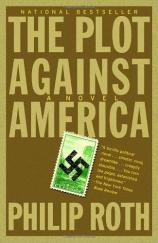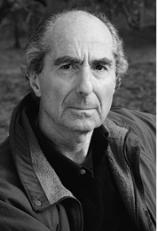The Plot Against America
Review
The Plot Against America
"Fear presides over these memories, a perpetual fear."
So began one of the most talked about and important books released in 2004: Philip Roth's THE PLOT AGAINST AMERICA. Released in the midst of the fall presidential campaign, the first line alone guaranteed that the book would create a stir. After all, we were now living in a nation of color-coded terror alerts, where military campaigns with names like "Enduring Freedom" morphed into a perpetual "new kind" of war. And the Fear was never further away than the unknown passenger sitting beside you on the plane or the odd-looking package left forgotten on the subway car or arriving in the mail.
The Fear came to American soil on 9/11, but on the surface, Roth's novel --- which was just released in paperback --- has nothing to do with post-9/11 America. He is writing about another time of fear 60 years ago. But the genius of this book is that it echoes and reflects the time in which it was written.
Roth is one of America's greatest novelists, winner of the Pulitzer Prize in 1997. In books from PORTNOY'S COMPLAINT to THE HUMAN STAIN, Roth has dealt directly with the major preoccupations of modern American life from sex to political correctness. But nowhere in PLOT does Roth mention today's America or current politics, which is one of the strengths of the book.
What Roth has written is a historical novel, or, more accurately, a "counterfactual" history. The book begins in 1940 and is told through the eyes of Roth himself, then a seven-year-old boy living with his older brother, cousin and parents in a working class, Jewish neighborhood in Newark, New Jersey. Roth is a normal kid with a prized stamp collection. His family life is a happy one. His parents are hardworking, decent people.
But then that world is turned upside down when the Republicans break a deadlocked convention by nominating an American hero, Charles A. Lindbergh, as their standard bearer for president in the 1940 election. Lindbergh is a leader of the America First movement, which promises to "preserve" America by keeping us out of the Second World War. Besides being sympathetic to Hitler and fascism, that movement and Lindbergh himself blame the Jews and President Roosevelt for trying to drag us into the war. "Vote for Lindbergh or Vote for War" is their emotional slogan.
"'No!' was the word that awakened us," the fictional Roth remembers of the night that Lindbergh is nominated. "'No!' being shouted in a man's loud voice from every house in the block. It can't be. No. Not for president of the United States."
But sure enough, Lindbergh easily beats FDR in the general election and America begins its slow descent into darkness. One of the first things President Lindbergh does is fly --- Lucky Lindy is always piloting his own plane, somewhat unwisely --- to Iceland to meet Hitler and reach an "understanding" that keeps America out of Europe's war. A similar "understanding" is soon reached with Japan.
Roth's father shares with his family "his irrepressible sense of impending disaster." And we are given a child's-eye view of that unfolding disaster. Early in Lindy's presidency, the family takes a Washington vacation in order to reassure themselves that American democracy and civil liberties still exist. It turns into a nightmare when the family is physically evicted from the hotel where they are registered. The father, not afraid to exercise his free speech and defend FDR, is publicly labeled a "loudmouth Jew."
This is a dark and terrifying book. Roth moves back and forth between what is happening in the news and how these events begin to tear apart and destroy this child's world. The big players of history --- Lindy, FDR and von Ribbentrop --- make cameo appearances and are mostly offstage. What makes this book powerful is Roth's childhood narrative. The scared child comes to see that his father is impotent to protect his family from the forces of history.
This is a work of imagination. But that child's fear comes with the terrible realization that there were millions of real people, adults and children, who experienced the exact same thing in Berlin in 1938 and the rest of Europe in the 1940s.
And then come those echoes of modern times. Lindy is a folksy kind of president. "The lean, tall, handsome hero, a lithe, athletic-looking man not yet forty years old, arrived in his flying attire, having landed his own plane at the Philadelphia airport only minutes earlier…" Hmm. A president wearing a flight suit? Lindy dons the outfit whenever he wants to reassure Americans.
"If fascism comes to America, it would be on a program of Americanism," Huey Long once famously said. And indeed, Lindy creates the Office of American Absorption to separate "city" kids from their parents and relocate them across the country to teach them the "traditional ways of heartland life." Philip's older brother takes part in this program, called "Just Folks," and returns home a Lindbergh apologist, much to the horror of his parents. Eventually, entire Jewish families will be "relocated" under "Homestead 42" and their communities broken up through the "Good Neighbor" policy.
The terminology of the fictional Lindbergh administration reminds many of the folksy, innocuous sounding USA Patriot Act of today. And indeed, before long, in Roth's book the FBI is grilling nine-year-old Philip about the political beliefs of his cousin, Alvin. And one cannot help but think of section 215 of the Patriot Act, which gives the FBI the power to question librarians about the reading habits of American citizens. Then there are those present-day cases where the names of citizens mysteriously land on airline "no-fly lists" even though their only crime is to be vocally anti-war.
Lindy repeats a PR slogan --- "An independent destiny for America" --- 15 times in his State of the Union message, and one cannot help but think of the "don't let the smoking gun be a mushroom cloud" slogan being repeated over and over again by government officials to justify invading and occupying another nation. Roth's fictional father says, "It means destroying everything that America stands for." And current names like Abu Ghraib and Guantanamo come to mind.
The real Philip Roth claims he had no such parallels in mind when he was writing this book. And maybe so. But even though the circumstances are radically different, Roth has managed to capture the uncertainty and fear of today's America in this book.
THE PLOT AGAINST AMERICA has a major weakness in the ending. Roth builds the drama to a feverish pitch: the Nazi Kristallnacht comes to the streets of America in the fall 1942. There are anti-Semitic pogroms in cities across the country; Jews are murdered in the streets; political opponents are assassinated and arrested; crosses burn on Jewish lawns. Then it is over in a flash. The nightmare recedes with the daylight and history resumes its correct march as the Japanese attack Pearl Harbor a year late.
But while the ending might be an improbable solution for an author who painted himself into a corner, it is what follows the book's conclusion --- Roth's Postscript --- that cements this as a great work. In that postscript, Roth gives us his historical sources, the biographies of real historical figures, and documentary proof that the story he wrote, indeed, could have happened here. Lindbergh was involved in America First and did accept a medal from Hitler's Germany and speak admiringly of the Nazis. And crypto-fascists like Henry Ford and Father Coughlin did stir up popular hatred against the Jews.
American democracy and civil liberties have always been fragile and threatened, from both internal and external threats. Our freedom can be taken for granted only at our collective peril. Perhaps the real lesson of THE PLOT AGAINST AMERICA could be best summed up by a founding father, Benjamin Franklin: "They that can give up essential liberty to obtain a little temporary safety deserve neither liberty nor safety."
Reviewed by Tom Callahan on September 26, 2005
The Plot Against America
- Publication Date: September 27, 2005
- Genres: Fiction
- Paperback: 391 pages
- Publisher: Vintage
- ISBN-10: 1400079497
- ISBN-13: 9781400079490










